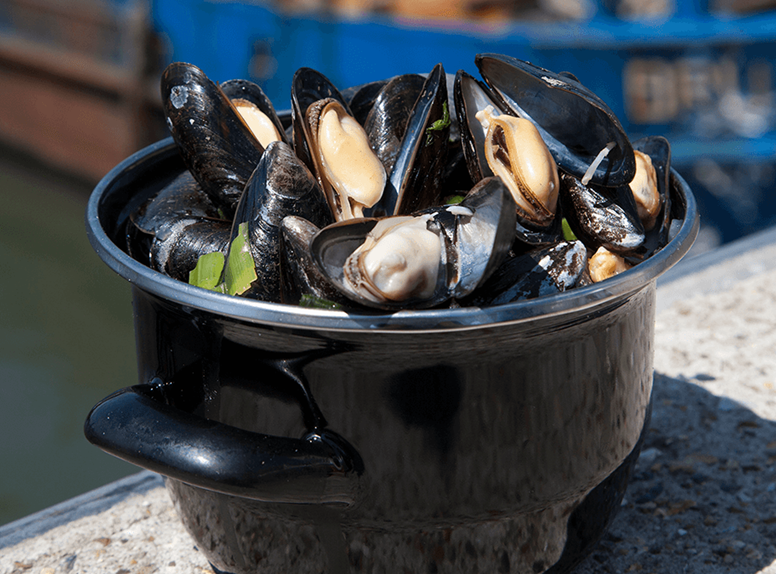

Culinary surprises from Zeeland
Enjoying and sharing salty delicacies is part of the Zeeland DNA. They are plucked from the sea to your plate, and just could not be any fresher. As well as meaty shellfish like mussel, oyster and lobster, we specialise in sea vegetables. On the tidal marshes, glasswort and sea lavender, better known as sea aster, abound. All these were once the food of the poor, but have become gourmet foods.
Mussels
For some people Zeeland can only mean one thing: mussels. Delicious, steaming mussels, fresh out of the sea! Cook them briefly with diced onion and parsley, add a teaspoon of real butter and enjoy. They are best washed down with a glass of white wine or a local beer. A pan full of white and orange mussels and the green of leek and celery make for a colourful dish. Scrumptious and healthy! Curious to know how easily mussels can be prepared at home?

Oysters
The taste of an oyster is the taste of the sea. They are best when brought fresh from the pure waters of the Oosterschelde. There are two kinds of oyster in Zeeland: the wild Pacific or Japanese oyster (‘creuse’) and the flat (or ‘platte’) oyster. Wild oysters can be eaten raw or grilled. Zeeland flat oysters have such a natural, delicate taste, it would be such a waste to grill them. They are almost always eaten raw. They should be served cool, with pepper and a drop of lemon juice. Yummy! You can also pick your own, but ask locals for the best spots. Everyone is allowed to collect a maximum of 10 kilos of shellfish for their own consumption per 24 hours.

Oosterschelde lobster
Our best known crustacean is the Oosterschelde lobster (‘kreeft’). Because they have next to no contact with lobsters from other waters, their DNA is unique and they have a distinctly different taste to the average European lobster. They can only be caught from 1 April to mid-July, and you’ll only enjoy them as long as those stocks last.
Oosterschelde lobster will be scarce in 2024, so it is advisable to check in advance with the restaurant of your choice for availability.

Glasswort
Among these vegetables, the early occupier of the bare flats is the glasswort. A sort of hairless cactus, it absorbs a lot of salt which gives it a typical briny taste. It does need freshwater rain for its buds to develop. With plentiful rain in the early spring, its bountiful harvest can last from mid-May to mid-September.

Sea aster
The salty sea vegetables live on the mudflats and marshes of Zeeland. Sea aster (‘lamsoor’) grow on the higher parts of the flats. With its long leaves, firm but not tough, it resembles lamb’s lettuce. Because it should be picked young, the harvest period is from mid-March to end-July.

Zeeland’s ‘bolus’
The ‘bolus’ - which also goes by the name of jikkemiene, stropiedroaier, koekedraoiomme of drolle - is a delicacy not to be missed in Zeeland. A bolus is made from white bread dough rolled in dark brown sugar in a spiral shape and then baked in the oven. Almost every baker in Zeeland makes their own bolus. Check out how you can bake your very own boluses!

Boterbabbelaar
In the past, when you ordered coffee or tea it would come with a Zeeuwse boterbabbelaar. It gets its name (literally ‘chatterbox’) because it would take a while to eat. The longer you stayed sitting, the longer you would talk, or ‘babbelen’. The main ingredients of the babbelaar are butter, sugar, glucose syrup, vinegar and water. Babbelaars are sold at village fairs and on high days and holidays. You can also find them in souvenir shops. Make your own!





